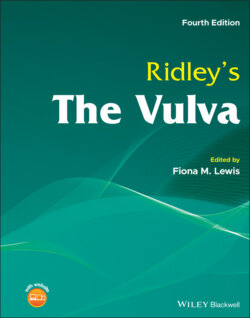Читать книгу Ridley's The Vulva - Группа авторов - Страница 31
Sex Chromosome DSD Turner’s syndrome
ОглавлениеTurner’s syndrome is reported to occur in 1 in 2500 live female births [25]. There is complete or partial absence of the sex chromosome – most have the karyotype 45,XO, but 15% have a 46,XX mosaic pattern, and 7–10% have some Y chromatin present. The ovaries, located in their normal anatomical positions, consist mainly of fibrous stroma and are termed streak gonads. Germ cells rarely survive meiosis, follicular formation usually fails, and the resulting streak gonads are sterile and devoid of endocrine activity. At birth the genital ducts and external genitalia are entirely female, although clitoral enlargement may occasionally be present. However, almost 25% of girls with Turner’s syndrome show some secondary sexual development, 2–5% menstruate due to some residual ovarian function, and rarely, can have spontaneous pregnancies [26], although these are high risk because of the associated cardiac complications. Patients with Turner’s syndrome are of short stature and exhibit a range of somatic abnormalities including webbing of the neck, coarctation of the aorta, and renal anomalies. There is also a predisposition to develop diabetes mellitus and other autoimmune diseases, particularly those affecting the thyroid [27]. Hormonal treatments are required, and these patients need multidisciplinary specialist management throughout life [28]. There is a reduced incidence of breast cancer, but increased risk of gonadoblastoma and endometrial cancers [29].
Table 1.2 Classification of disorders of sexual development (DSDs).
| 1. Sex chromosome DSD |
| Turner syndrome (45,X) Klinefelter syndrome (47,XXY) Mosaicism 45,X/46,XY Triple XXX syndrome XXYY syndrome |
| 2. 46,XX DSD |
| Androgen induced/androgen excessCongenital adrenal hyperplasia (CAH)Placental aromatase deficiencyGlucocorticoid receptor mutationMaternal androgen secreting tumours (e.g. luteomas)Androgenic drug exposure OthersSyndromic associations, e.g. cloacal dystrophiesMüllerian agenesisVaginal atresiaUterine anomalies |
| 3. 46,XY DSD |
| Disorders of androgen synthesis and actionLH receptor mutationsSmith–Lemli–Opitz syndromeCholesterol side chain cleavageSteroid protein mutations5∝‐reductase deficiencyAndrogen insensitivity syndromeLeydig cell agenesis OthersSyndromic association of male genital development, e.g. hand‐foot‐genital, cloacal dystrophiesPersistent Müllerian duct syndromeCryptorchidismCongenital hypogonadotropic hypogonadism |
| 4. Disorders of gonadal developmentComplete or partial gonadal dysgenesisOvotesticular DSD |
